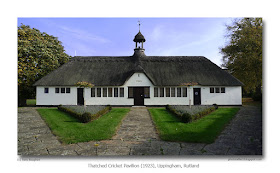,-Uppingham,-Rutland.jpg) click photo to enlarge
click photo to enlargeA cricket pavilion in a village or small town often has to fulfill a number of purposes. It is a meeting place for a team and its supporters; a vantage point (often raised) from which to sit and watch the game; a place in which to change into cricket "whites"; somewhere that refreshments can be prepared and served; and often it includes a scoreboard or box in which the progress of the match is recorded, and a clock.
But, whilst the functional aspects are clearly most important attributes of this type of building, cricket pavilions are often designed with aesthetic considerations in mind too. Often they are symmetrical, with centrally placed steps out of which the players issue. Gable ends and decorative barge boards frequently feature in their make-up. So too do clock turrets, bay windows (for a good view) and balustrades. In fact, they sometimes seem to combine the details of a bungalow and a miniature town hall! And then there are the thatched pavilions! Thatch pretty much died out as a first-choice roofing material in the seventeenth century when clay tiles began to be more widely available and affordable. So one wonders why it re-appeared in the early twentieth century on quite a few houses, barns and, yes, cricket pavilions. The answer lies in the Arts and Crafts Movement which sought to revive traditional techniques and materials, but use them in a modern way.
This pavilion at Uppingham, Rutland, even though it was built as late as 1923, shows the influence of Arts and Crafts ideas in the plain white walls, the simple, vertical, closely spaced windows, the half-height glazing to each side of the entrance door, and in that thatched roof with its thatched bell-tower. There are two further interesting aspects to this pavilion. Firstly, most such buildings have a front facing the field of play - as this one does. They also have a definite "back" that is utilitarian in character because it is often close to the field boundary. The location of Uppinham's pavilion, at a corner where two roads meet has led to the architect giving it a second front at the back - the one in my photograph. The second aspect that puzzles me is this. Why, when so much effort has gone into making the facade (and its landscaping) symmetrical, is its perfection broken by the single small window on the left?
photograph & text (c) T. Boughen
Camera: Lumix LX3
Mode: Aperture Priority
Focal Length: 5.1mm (24mm/35mm equiv.)
F No: f4
Shutter Speed: 1/640
ISO: 80
Exposure Compensation: -0.66 EV
Image Stabilisation: On